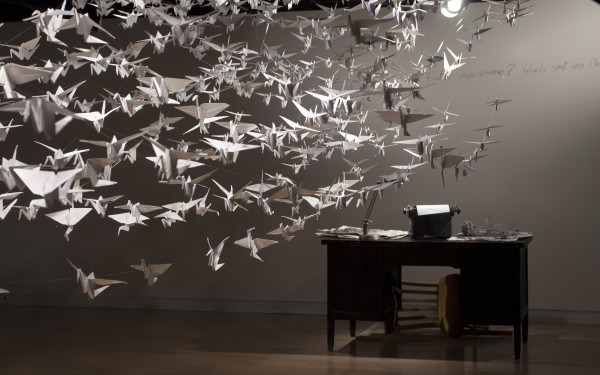Forgotten Boroughs
Historians Present Book on Archived Photographs Documenting Bygone Montreal Neighbourhoods
Snapshots of women hanging laundry in makeshift courtyards and back alleys, children hanging over precariously built railings and curious residents and shop owners staring at city workers photographing corner stores—these are the only mementos of parts of Montreal’s working-class history.
The archived photos of old lopsided houses from Quartiers Disparus are from a bygone era and present what was lost when Montreal sought modern metropolis status.The book, Quartiers Disparus – based off an exhibition originally shown at the Centre d’histoire de Montreal in collaboration with the city’s archives—will be presented once again at McGill’s Centre for Interdisciplinary Research on Montreal this Thursday.
Most of the historical research focused on the forgotten Red Light District, Goose Village and Faubourg à m’lasse, mostly demolished from 1957 to 1964 to make way for a modern city.
Sex workers and gamblers
Remnants of the former Red Light District are still somewhat visible. The area between St. Laurent Blvd. and St. Hubert St., where you find most of the UQAM campus, is still home to many of the city’s strip clubs and sex shops.
Much of the area was demolished in 1957 and 1958 and replaced with 788 social housing units, the Habitations Jeanne-Mance.
In the mid-1900s, the Red Light District was considered a hotbed for criminal activity, but the people that grew up in the area didn’t feel that way.
“When we think Red Light, we think prostitutes and gamblers,” said co-author Catherine Charlebois, a museologist at the Centre d’histoire de Montréal. “But there were many families there.”
More so than the result of the Quiet Revolution, which saw Quebec invest in its own infrastructure and social systems and enforce secular policies, Charlebois says the city was marked by a modern revolution.
Urban planning turned away from the “cramped” and “unhygienic” old neighbourhood structures and moved towards wide open spaces in the form of parks, public centres, highways and suburbanization.
Coming out of WWII, Charlebois says North Americans dreamed of metropolis.
“We felt that the cities we had were the cities of the industrial revolution,” she said. “They weren’t adapted for modern life.”
The car was also becoming an icon—and a headache, says Charlebois. A highway that led directly to the downtown core was the solution to modern living.
Cities were reorganized: the city centre was for business, for working, for trade.
“The idea wasn’t to live downtown, the functions for living existed on the periphery,” said Charlebois.
Labourers were the main residents of the downtown areas and were only there because they couldn’t afford to get out.
“They didn’t have the money to buy a house in the suburbs and have nice grass and a pool,” Charlebois said.
Now it’s a bit of the inverse, she added. People are obliged to go to the suburbs because it’s less expensive to raise a family.
Mayor Jean Drapeau spearheaded the modernization of Montreal. His terms from 1954 to 1957 and again from 1960 to 1986 coincide with the “renewal” of the city and the disappearance of the low-income neighbourhoods.
The desire to create space meant starting from scratch, eliminating traces of the industrial revolution by demolishing the neighbourhoods that served only as reminders.
“At the time, there wasn’t a notion of keeping what is good and demolition what should be demolished,” Charlebois said. “There was no concept of recycling or recuperation.”
Les Habitations Jeanne-Mance was the ideal modern structure. It released occupied land to make way for parks, playing grounds and green spaces to help the area breathe.
Goose Town
Of all the forgotten neighbourhoods, the most devastating loss was Goose Village.
About 1,500 residents were displaced and 350 buildings were torn down, including its Victorian-style homes, a school, a playing field, a recreational centre and a former church-turned-factory—only a fire station and gin distillery escaped the destruction.
“We demolished it all; there’s nothing that remains,” Charlebois said.
The area by Victoria Bridge was destroyed in 1964 to make way for Expo 67, the international event that would raise Montreal’s status as a major city.
Goose Village, with its reeking stockyards and tanneries, stood in the way of that goal. By the 1960s, it was mostly inhabited by Italian immigrants, who didn’t amount much of an opposition.
The residents of Goose Village spread out to the neighbouring South West, Pointe St. Charles, LaSalle, Verdun and even Greenfield Park on the South Shore. They were faced with the challenge of finding equally cheap places to live.
In the end, there isn’t anything left of the Autostade—the football stadium built for Expo 67 on the razed Goose Village land. Now it mostly consists of a Costco, a train station and parking lots.
Molasses memories
Since the creation of CBC/Radio-Canada in 1936, the public broadcaster’s French-language service had managed to spread its resources throughout the city in some 40 different locations.
Here, Drapeau saw an opportunity to fulfill another dream: a dream of a broadcast city, a district where television and radio stations were concentrated.
The broadcast city would be the eastern city centre—counterbalancing the traditional business district to the west, a predominantly Anglophone area.
“We dreamed of a centre that was more Francophone, where we could have public installations,” said Charlebois. “Radio-Canada was the motor for that.”
Near the port east of Berri St., the smell of molasses was strong. According to Charlebois, the nearby sugar refinery was only a reminder of what the low-income labourers could not afford. Instead, everyone ate the imported molasses.
By 1963, the 5,000 mostly French-Canadian residents were told to vacate the area; the planned broadcast city would reclaim the flattened area and launch the downtown of the east.
But the broadcast city never came. The planning was drawn out to 10 years until the current CBC/Radio-Canada tower was built.
Where 5,000 once lived there is now a tower, a few scattered buildings and parking lots.
“The city isn’t static, it transforms constantly,” Charlebois said. “In areas with older buildings, like Griffintown, we always ask ourselves, ‘What do we keep?’”
While Charlebois says there are many comparisons between urban redevelopment then and now, the Habitations Jeanne-Mance, the Radio-Canada tower and Expo 67 were different because they were government projects.
They were developed with collective ideals.
In contrast, in Griffintown today, the city is attracting private interests, mainly in the form of condo developers.
The forgotten neighbourhoods from 1957 to 1964 were much more dramatic.
Charlebois remembers the testimony of one woman, who compared it to a death.
“They had to mourn the loss of their neighbourhood,” she said. “They couldn’t go back.”
Quartiers Disparus revisits the memories of boroughs, whose residents exhibited a “village spirit.” Closed networks between residents existed beyond the dated homes and unpleasant odours, and some areas were intertwined with the histories of the families that inhabited them for generations.
Quartiers Disparus // Thursday, Jan. 29 // 11:45 a.m. // CRIEM CIRM (3438 McTavish Ave) // Free Admission

_829_1050_90.jpg)
_833_1050_90.jpg)
_600_832_s.png)


2_600_375_90_s_c1.jpg)
_600_375_90_s_c1.jpg)
